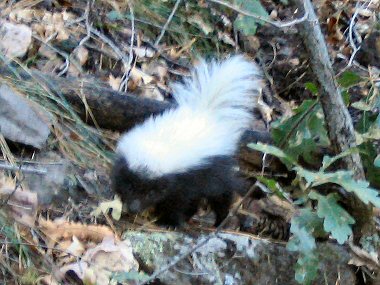| Skunks are members of the weasel family
(which also includes badgers, otters, ferrets and weasels). Only badgers
and skunks are found in the desert. Skunk species that live in the
Sonoran Desert include the spotted skunk, striped skunk, hooded skunk and
hog-nosed skunk. Skunks walk flat footed instead of on their toes, this
gives them their distinctive waddling, shuffling gait. |
Skunks are nocturnal animals and are
famous for their ability to spray a noxious stinky fluid to deter
predators. The only predator skunks have (other than people and cars) is
the great horned owl,
 which
doesn't have a well developed sense of smell. They contain enough stink
for about 5-6 shots which they can spray a distance of 12 feet. Their
bold black and white patterns advertise that they are not to be trifled
with. They seem to be aware of their power and are generally mellow and
non-aggressive. which
doesn't have a well developed sense of smell. They contain enough stink
for about 5-6 shots which they can spray a distance of 12 feet. Their
bold black and white patterns advertise that they are not to be trifled
with. They seem to be aware of their power and are generally mellow and
non-aggressive.
|
The photo at right is of a Hooded
Skunk - distinguished by the white top and and long, lush white
plume for a tail. |
Skunks are omnivores and eat almost anything, from
beetles, grubs and grasshoppers to rodents, birds, eggs, seeds and
fruit. They find their meal by snuffling around or digging, looking
under rocks, logs and debris. Skunks sometimes build their own dens, but
often will share the dens of other animals (like pack rats) or make use
of brush piles, hollow logs, boulder piles or buildings. Skunks do not
hibernate, but they gain extra weight in the fall to tide them over the
winter months. Most skunks breed in the spring (except the spotted skunk
which breeds in fall) and give birth in May. The 3-7 kits stay with the
mother throughout the summer and accompany her on nocturnal food finding
expeditions before dispersing in the fall. |

